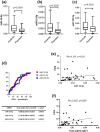miR-16-5p, miR-21-5p, and miR-155-5p in circulating vesicles as psoriasis biomarkers
- PMID: 40011539
- PMCID: PMC11865590
- DOI: 10.1038/s41598-025-91532-9
miR-16-5p, miR-21-5p, and miR-155-5p in circulating vesicles as psoriasis biomarkers
Abstract
Psoriasis is a chronic skin disorder marked by fast skin cell growth, leading to thick, red, scaly patches. MicroRNAs are small, non-coding RNA molecules that play a crucial role in post-transcriptional gene regulation. This study investigates miR-16-5p, miR-21-5p, and miR-155-5p expression in psoriasis EVs and assesses their biomarker potential, exploring associated target genes and pathways via bioinformatics. A cross-sectional and case-control study included 40 psoriasis patients, with blood samples collected in EDTA tubes. RNA from extracellular vesicles was isolated using Qiagen kits, and miRNAs were quantified via RT-qPCR. Bioinformatic analysis predicted target genes using databases like miRDB and TargetScan. Gene expression data from GEO was processed, and differentially expressed genes were identified. This study assessed miR-16-5p, miR-21-5p, and miR-155-5p expression in psoriasis patients' circulating vesicles versus controls, finding significantly lower levels in patients. ROC analysis confirmed their diagnostic potential. A positive correlation of miR-16-5p with the Psoriasis Area Severity Index (PASI) suggests severity marker potential. Bioinformatics identified 378 common dysregulated genes, revealing key pathways and gene interactions in psoriasis. A heat map confirmed miRNA-mediated gene suppression in the disease. This study identifies miR-16-5p, miR-21-5p, and miR-155-5p as potential psoriasis biomarkers, in addition to finding significant gene interactions and pathways involved in psoriasis pathophysiology.
Keywords: Bioinformatics; Biomarkers; Extracellular vesicles; MicroRNAs; Microarrays; PASI; Psoriasis; Psoriasis area severity index.
© 2025. The Author(s).
Conflict of interest statement
Declarations. Competing interests: The authors declare no competing interests.
Figures


References
MeSH terms
Substances
LinkOut - more resources
Full Text Sources
Medical

